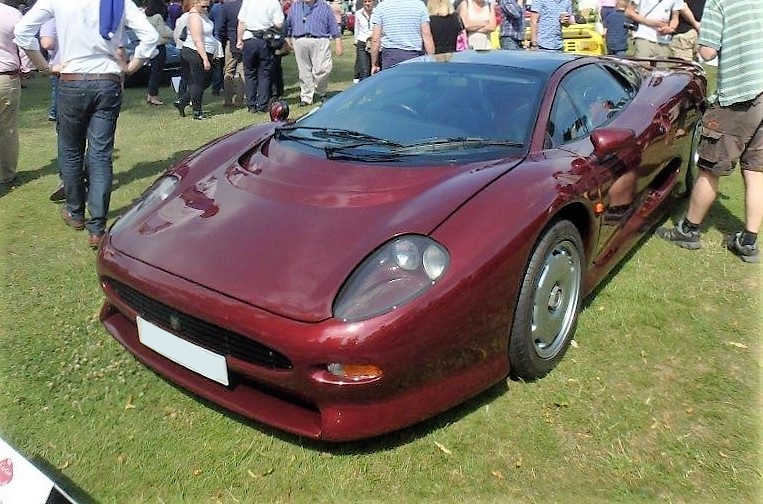-
Insurance
InsuranceAbout our productsLearn about insuringGet a quote Get current values, historical values, model history and more.
-
Valuation
ValuationHagerty valuation toolLook up a vehicle value Get current values, historical values, model history and more.
-
Events
EventsHagerty official eventsHagerty ClubhouseEvent calendar
-
Entertainment
EntertainmentMore to explore
- Portal login
1993 Jaguar XJ 220
Base Coupe 3.5 L
Vehicle values by condition
Fair
Condition 4
£248,000
#4 cars are daily drivers, with flaws visible to the naked eye. The chrome might have pitting or scratches, the windshield might be chipped.
Good
Condition 3
£324,000
#3 cars could possess some, but not all of the issues of a #4 car, but they will be balanced by other factors such as a fresh paint job or a new, correct interior.
Excellent
Condition 2
£404,000
#2 cars could win a local or regional show. They can be former #1 cars that have been driven or have aged. Seasoned observers will have to look closely for flaws.
Concours
Condition 1
£503,000
#1 vehicles are the best in the world. The visual image is of the best car, unmodified, in the right colours, driving onto the lawn at the finest concours.
Insurance premium for a
1993 Jaguar XJ 220 Base Coupe 3498
valued at £324,000
£3290.30
/ year*
History of the 1992 - 1994 Jaguar XJ 220

1992 - 1994 Jaguar XJ 220
The Jaguar XJ220 was in production from 1992 until 1994, and is one of the fathers of the hypercar generation. It is a mid-engine, rear-wheel-drive sports car that seats two people, and is capable of speeds in excess of 210mph.
The original prototype was shown at the 1988 Birmingham Motor Show, and had been developed very cheaply by a variety of Jaguar’s subcontractors. Jaguar harboured a desire to increase the similarity between its Le Mans XJR racers and its road cars, and the XJ220 was to be the start of this project. The prototype features an extensively tuned Jaguar V12 and four-wheel drive, neither of which was used on production cars. 1500 orders were taken at the show with deposits of £50,000, but many buyers chose not to exercise their right when the production model was announced.
The production car when launched in 1992 used a turbocharged V6, had rear-wheel drive, and the scissor doors were replaced with conventional doors. At £470,000 it was still the most expensive new car on sale at launch, and many were heavily discounted when unsold years after production ended.
Competition versions of the car dubbed XJ220C were campaigned in several GT racers including the GT class at Le Mans, and six XJ220S road cars were produced as a development of the XJ220C. Pininfarina also modified one car for the Sultan of Brunei.
The Jaguar XJ220 uses a 3.5-litre V6 engine derived from the V64V engine in the MG Metro 6R4 rally car. This in turn was very loosely based around the Rover V8. In the XJ220, this engine – now dubbed JV6 - was twin-turbocharged using a pair of Garrett T3s, and was mated to a five-speed manual gearbox. Unlike the original concept car, production XJ220s were rear-wheel drive.
Jaguar XJ220s feel wide to drive – and for that reason don’t expect to own one if you live anywhere in London; it won’t fit through the width restrictors. Most alarming are the ride and the interior. It’s incredibly smooth for a hypercar, and the interior is more than ample for a pair of tall and wide people – provided you can get through the narrow door apertures!
To drive, it’s heavy – non-assisted steering, a meaty clutch, and a long-throw, notchy gearbox. Yet this weight doesn’t make it difficult. It’s responsive, docile, easy to drive – it doesn’t feel like a hypercar in the traditional sense. Fuel economy is reportedly excellent for a car of this type, though that tends not to be an issue for people buying cars in this class.
Parts supply for hypercars such as the Jaguar XJ220 is rarely an issue, as if you can afford to buy the car in the first place, you can afford to have parts remanufactured. However, an amusing side-note is that the rear light lenses are shared with the Rover 200.
Don Law is the premier Jaguar XJ220 specialist, and acquired Jaguar’s complete spares stock in 2008. Don Law Racing can provide anything from a brand new XJ220 bonnet to a gearbox, and countless small items in between. Don Law will also upgrade your XJ220 – from improved brake servos to a boot which is 260% larger than standard.
The Jaguar XJ220S limited edition cars will always be most desirable, as road-going derivatives of the racer – but with just six built, finding one will be difficult. Barring those, the rest of the run were fairly similar. Low mileage, historied cars will always be worth the most, but with so few to choose from pretty much any XJ220 will find a home.
The closest to an equivalent Jaguar would be an XKR, and yet the two are in no way similar. Better alternatives to an XJ220 would include Ferrari’s F40 and Bugatti’s EB110
Hagerty Newsletter
Get your weekly dose of car news from Hagerty UK in your inbox

ADVERTISEMENT